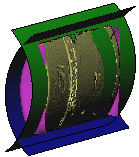Surface Extraction PropertyManager
Use this PropertyManager to extract sub-meshes from the model as surfaces.
You later can convert the surfaces into solids using the SolidWorks surface
tools such as Trim, Knit,
and Thicken. To manually extract
surfaces, select a sub-mesh, then select a surface type under Face
Settings.
|

|

|
|
Model before surface extraction |
Model after extracting two cylindrical and two b-spline surfaces |
|
When you extract surfaces, you might see salient sub-meshes (arrows),
which are transitions between primary mesh regions. Transition regions
usually show a large variation in geometry, such as curvature. You usually
do not convert salient sub-meshes as surfaces during guided surface creation,
but instead you create these surfaces later in SolidWorks. |

|
Surface Extraction
Global Extraction
Extract All Faces.
Extracts all sub-meshes, whenever possible as analytical surfaces. The
number of sub-meshes to extract appears next to Regions
unspecified. When extraction is complete, click  to
complete the model, or select surfaces to change their settings and shapes.
to
complete the model, or select surfaces to change their settings and shapes.
Extract Remaining
Faces. After you extract at least one surface, the button name
changes so you can extract all remaining sub-meshes.
Face Settings
Example of extracting a sub-mesh as a cylinder  .
The pointer displays an icon for the type of extracted surface as you
hover over it.
.
The pointer displays an icon for the type of extracted surface as you
hover over it.
Plane
 . Extracts sub-mesh as a planar surface. Set a value for
Offset to reposition the
plane relative to the mesh.
. Extracts sub-mesh as a planar surface. Set a value for
Offset to reposition the
plane relative to the mesh.
Cylinder
 . Extracts sub-mesh as a cylindrical surface. Set a value
for Radius.
. Extracts sub-mesh as a cylindrical surface. Set a value
for Radius.
Cone  . Extracts sub-mesh as a conical surface. Set values for Angle, Top
Radius, and Bottom Radius
to refine the cone's shape.
. Extracts sub-mesh as a conical surface. Set values for Angle, Top
Radius, and Bottom Radius
to refine the cone's shape.
Sphere
 . Extracts
sub-mesh as a spherical surface. Set a value for Radius. For Center,
set X, Y, and Z values to position the sphere's center relative to the
origin.
. Extracts
sub-mesh as a spherical surface. Set a value for Radius. For Center,
set X, Y, and Z values to position the sphere's center relative to the
origin.
Torus  . Specify a single mesh
region to form a surface, similar to a face created by a fillet. Set values
for Profile Radius and Path
Radius.
. Specify a single mesh
region to form a surface, similar to a face created by a fillet. Set values
for Profile Radius and Path
Radius.
Extrude  . Extracts sub-mesh as
an extrude. Specify a single wall of adjacent mesh faces that form a surface,
similar to an extrude.
. Extracts sub-mesh as
an extrude. Specify a single wall of adjacent mesh faces that form a surface,
similar to an extrude.
 For Extrude
and Revolve: All mesh faces must
be part of one mesh to be extracted together as an extrude or revolve.
Use the Surface Wizard's paint tools in the Face
Identification PropertyManager to identify the mesh faces with
the same color.
For Extrude
and Revolve: All mesh faces must
be part of one mesh to be extracted together as an extrude or revolve.
Use the Surface Wizard's paint tools in the Face
Identification PropertyManager to identify the mesh faces with
the same color.
Ruled  . Specify a single mesh region to form a surface, similar
to a two-profile loft with no guide curves. Set values for Offset
distance 1 and Offset distance
2 to extend the ruled surface.
. Specify a single mesh region to form a surface, similar
to a two-profile loft with no guide curves. Set values for Offset
distance 1 and Offset distance
2 to extend the ruled surface.
BSpline
 . Extracts sub-mesh as a b-spline surface. A mesh lets
you visualize the surface. Set a value for Tolerance
to refine the b-spline surface shape by adjusting the deviation between
the surface and the mesh. The greater the deviation, the smoother the
surface. The Maximum and Average Deviation are reported. Select
Display deviation analysis to
display the mesh to surface deviation. Modify the number of UV curves
and re-position them to improve the surface.
. Extracts sub-mesh as a b-spline surface. A mesh lets
you visualize the surface. Set a value for Tolerance
to refine the b-spline surface shape by adjusting the deviation between
the surface and the mesh. The greater the deviation, the smoother the
surface. The Maximum and Average Deviation are reported. Select
Display deviation analysis to
display the mesh to surface deviation. Modify the number of UV curves
and re-position them to improve the surface. 
Delete Surface. Deletes the
selected extracted surface. This does not affect the sub-mesh used to
extract the surface.
Hidden Surface
As you work on extracting surfaces, you can right-click the extracted
surfaces and select Hide. Note
that  indicates a mesh feature, which you cannot hide.
indicates a mesh feature, which you cannot hide.
 Lists extracted surfaces
that are hidden.
Lists extracted surfaces
that are hidden.
Related Topics
ScanTo3D Overview